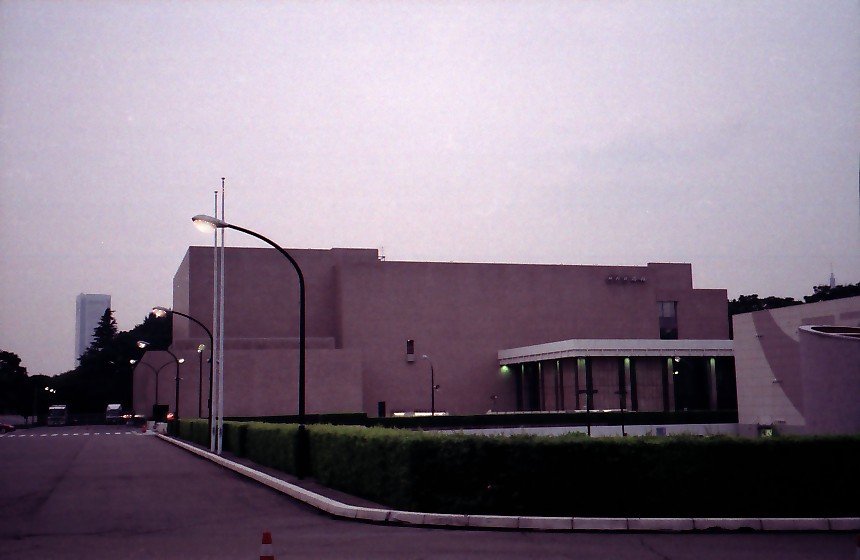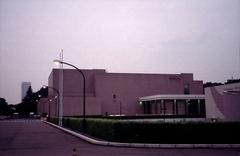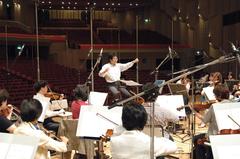
NHK Hall Tokyo: Visiting Hours, Tickets, Accessibility, and Visitor Guide
Date: 14/06/2025
Introduction
NHK Hall Tokyo is a renowned cultural landmark in the heart of Shibuya, Tokyo, seamlessly blending rich history, innovative architecture, and a pivotal role in Japan’s broadcasting and performing arts. Since its inception in 1955 and relocation to its present fan-shaped auditorium in 1973, NHK Hall has become the principal stage for the NHK Symphony Orchestra and the iconic New Year’s Eve “Kōhaku Uta Gassen” broadcast. With a seating capacity of approximately 3,800 and world-class acoustics designed by Minoru Nagata, the hall offers an exceptional auditory and visual experience for audiences of all backgrounds.
Whether you’re a music lover, history enthusiast, or visitor exploring Tokyo’s vibrant culture, this guide provides comprehensive details on NHK Hall’s visiting hours, ticketing, accessibility, nearby attractions, and practical travel tips. For the latest event schedules and booking, consult the NHK Hall Official Website and NHK Symphony Orchestra.
Contents
- Location and Access
- Visiting Hours and Tickets
- Historical Overview & Architectural Evolution
- Broadcasting and Musical Significance
- Visitor Experience & Facility Features
- Accessibility Guide
- Nearby Attractions
- FAQ
- Recent Renovations & Future Outlook
- Practical Visitor Tips
- Conclusion & Call to Action
- Sources
Location and Access
NHK Hall is located within the NHK Broadcasting Center at 2-2-1 Jinnan, Shibuya-ku, Tokyo. The hall is easily accessible:
- By Train: 10-minute walk from Shibuya Station (JR, Tokyo Metro, and private lines). Harajuku Station (JR Yamanote Line) and Meiji-Jingumae Station (Tokyo Metro) are also nearby, ensuring convenient access for visitors (Go Tokyo Accessibility).
- By Bus: Multiple routes connect the Shibuya area.
- On Foot: Walking distance from major Shibuya landmarks.
Visiting Hours and Tickets
Visiting Hours
NHK Hall’s opening hours are event-driven, with the box office typically open from 10:00 AM to 6:00 PM on weekdays and until showtime on event days. For accurate timings, always check the NHK Hall Official Website or specific event listings.
Ticketing
- Purchase Options: Tickets are available online, via NHK Symphony Orchestra, at authorized agencies, or the venue box office.
- Pricing: Prices vary by event and seat zone, generally ranging from ¥3,000 to ¥15,000. Discounts may be offered for students, seniors, or groups.
- Booking Tip: Popular events, especially NHK Symphony Orchestra concerts and “Kōhaku Uta Gassen,” sell out quickly—early booking is strongly recommended.
- Guided Tours: Occasionally available; check the official website for details.
Historical Overview & Architectural Evolution
- Origins: Opened in 1955 in Uchisaiwai-cho, Tokyo, as a pioneering venue for live broadcasts and musical events.
- Current Hall: Established in 1973 at the NHK Broadcasting Center, designed by Nikken Sekkei with acoustics by Minoru Nagata (Routledge Sample PDF).
- Design: The iconic fan-shaped auditorium seats around 3,800, enhancing sightlines and acoustic quality. Terraced seating and multiple balconies create an intimate feel even in a large space (Routledge Sample PDF).
Broadcasting and Musical Significance
- NHK Symphony Orchestra: NHK Hall is the principal venue, hosting over 120 concerts annually, many broadcast nationwide (NHK Symphony Orchestra) (Bachtrack NHK Symphony Orchestra).
- Kōhaku Uta Gassen: The legendary New Year’s Eve broadcast attracts millions, symbolizing national tradition (Wikiwand NHK Hall).
- Other Events: Japan Music Awards, Tokyo Jazz Festival, and diverse concerts underscore NHK Hall’s dynamic programming (Tripomatic NHK Hall).
Visitor Experience & Facility Features
- Atmosphere: Acclaimed for superb acoustics, clear sightlines, and a modern yet understated design.
- Amenities: Cloakrooms, kiosks, vending machines, clean restrooms, and accessible facilities.
- Accessibility: Step-free entrances, elevators, wheelchair seating, and tactile guidance for visually impaired guests (Accessible Japan).
- Photography: Allowed in public spaces, but restricted during performances (NHK Hall Wikimedia Commons).
- Guided Tours: Periodically available, offering insights into the hall’s architecture and broadcasting history.
Accessibility Guide
NHK Hall prioritizes inclusivity:
- Wheelchair Access: Ramps, elevators, accessible restrooms, and reserved seating.
- Assistance: Trained staff and advance booking options for additional needs.
- Transportation: Accessible routes from Harajuku and Meiji-Jingumae stations (Tokyo Universal Design Navigator).
- Additional Services: Service animals welcome; assistive listening devices may be available.
Nearby Attractions
Enhance your visit with nearby highlights:
- Yoyogi Park: Tokyo’s vast green oasis, ideal for walks and seasonal events (Living Nomads).
- Meiji Jingu Shrine: A serene Shinto shrine nestled within a forest.
- Harajuku/Takeshita Street: Renowned for youth fashion and vibrant street culture.
- Shibuya Crossing: The iconic pedestrian scramble.
- Omotesando: Tree-lined boulevard with high-end boutiques and cafes.
- Dining: Numerous accessible restaurants and cafes in Shibuya and Harajuku.
Recent Renovations & Future Outlook
- Seismic Retrofitting: From March 2021 to June 2022, NHK Hall underwent major upgrades to meet earthquake safety standards, with enhancements to comfort, accessibility, and technology (Wikiwand NHK Hall).
- Future Development: As part of the NHK Broadcasting Center redevelopment, further improvements are planned through 2036, balancing heritage and innovation.
Practical Visitor Tips
- Best Seats: For optimal acoustics, choose center seats on the main floor or first balcony (Routledge Sample PDF).
- Arrive Early: Especially for live broadcasts or popular shows.
- Public Transport: Strongly recommended due to central Tokyo traffic.
- Accessibility: Use barrier-free routes and avoid rush hour for smoother travel (Go Tokyo Accessibility).
- Download the Audiala App: For ticketing and event updates.
Frequently Asked Questions (FAQ)
Q: What are NHK Hall’s visiting hours?
A: Hours depend on scheduled events; the box office is typically open from 10:00 AM until showtime. Check the official website for specifics.
Q: How can I buy tickets?
A: Purchase via the official NHK Hall website, authorized vendors, or at the box office. Early booking is advised.
Q: Is NHK Hall wheelchair accessible?
A: Yes, including step-free access, elevators, reserved seating, and staff assistance.
Q: Are guided tours available?
A: Occasionally, as announced on the official website.
Q: What attractions are nearby?
A: Yoyogi Park, Meiji Shrine, Harajuku, Shibuya Crossing, and Omotesando.
Conclusion & Call to Action
NHK Hall Tokyo stands as a beacon of Japan’s cultural heritage, renowned for its outstanding acoustics, diverse programming, and commitment to accessibility. Whether attending a world-class classical concert, exploring the subtle elegance of its architecture, or discovering Tokyo’s vibrant neighborhoods, NHK Hall promises a memorable and enriching experience.
Plan your visit today:
- Check the NHK Hall Official Website and NHK Symphony Orchestra for event calendars and tickets.
- Download the Audiala app for the latest concert schedules and exclusive content.
- Explore nearby attractions for a full cultural itinerary.
Useful Links
- NHK Hall Official Website
- NHK Symphony Orchestra
- Shibuya Tourism Guide
- TravelCaffeine Tokyo Guide
- Operabase NHK Hall
- Accessible Japan
- Tokyo Universal Design Navigator
- Living Nomads – Top Places to Visit in Tokyo
- NHK Hall Wikimedia Commons
- Routledge Sample PDF
- Tripomatic NHK Hall
- Audiala App
Images, maps, and virtual tours are available on the official NHK Hall website and authorized tourism platforms.































































































































































































































